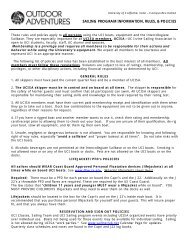J22 Manual - UCI Campus Recreation
J22 Manual - UCI Campus Recreation
J22 Manual - UCI Campus Recreation
You also want an ePaper? Increase the reach of your titles
YUMPU automatically turns print PDFs into web optimized ePapers that Google loves.
<strong>UCI</strong> J/22 Sailing <strong>Manual</strong> 10<br />
slug-pin in the mast slot to hold the sail slugs in place while rigging. Note: the slug-pin is a <strong>UCI</strong><br />
addition to the J/22. It makes rigging and unrigging easier by holding the sail-slugs in the mast<br />
slot.<br />
4. Take up the slack in the main halyard and re-cleat it.<br />
5. Form a pocket using the bottom of the sail and stuff the rest of the sail into it. Use a sail tie<br />
to secure the sail to the boom.<br />
6. Untie the mainsheet from the boom. It should be tied with a clove-hitch.<br />
7. Leave the mainsheet cleated to stabilize the boom.<br />
8. Release and slacken the boom vang.<br />
Prepping the Jib<br />
1. Detach the spinnaker halyard (blue line) and the<br />
spinnaker pole topping lift (white line with red<br />
flecks) from the jib tack shackle or bow pad-eye<br />
and attach them to the ring on the front of the<br />
mast. Take up the slack in these lines. The lines<br />
are controlled from the cleats on the cabin top.<br />
2. Unfold the jib making sure that tack (the front<br />
lower corner) is toward the bow.<br />
3. Attach the jib tack to the jib tack shackle. Starting<br />
at the bottom, attach the jib hanks (the springhooks<br />
attached to the luff of the jib) to the<br />
forestay; clip them on from the same direction all<br />
the way up to the head of the jib. When you<br />
reach the head, make sure the jib halyard runs<br />
clear to the mast, then attach the jib halyard to<br />
head of jib.<br />
4. Uncoil the jib sheets and lead them aft through the fairlead blocks mounted on tracks on the<br />
deck. Tie a figure-eight knot in the end of each jib sheet.<br />
Checking the Backstay<br />
Be sure to have some tension on the backstay before you leave the docks. It should never be<br />
completely slack. The backstay adjustment is located in the cockpit forward of the traveler cleats.<br />
Generally, you will want the backstay tighter in heavy winds and not so tight in lighter winds. Also,<br />
it should be tighter when going to weather in order to keep the jib luff tight.<br />
Note: Tighten backstay by hand.<br />
Preparing to Leave the Dock<br />
Before you leave the slip, you must have everything ready to go and double-checked so that<br />
you don't occupy the exit channel any longer than necessary. The space between the docks is<br />
narrow and other boats may need or want to enter or exit. Train your crew in their<br />
responsibilities while safely in the slip. For example, if you have two crew members, one should<br />
hold the tiller to help the boat back straight and avoid obstacles, while the other person can







